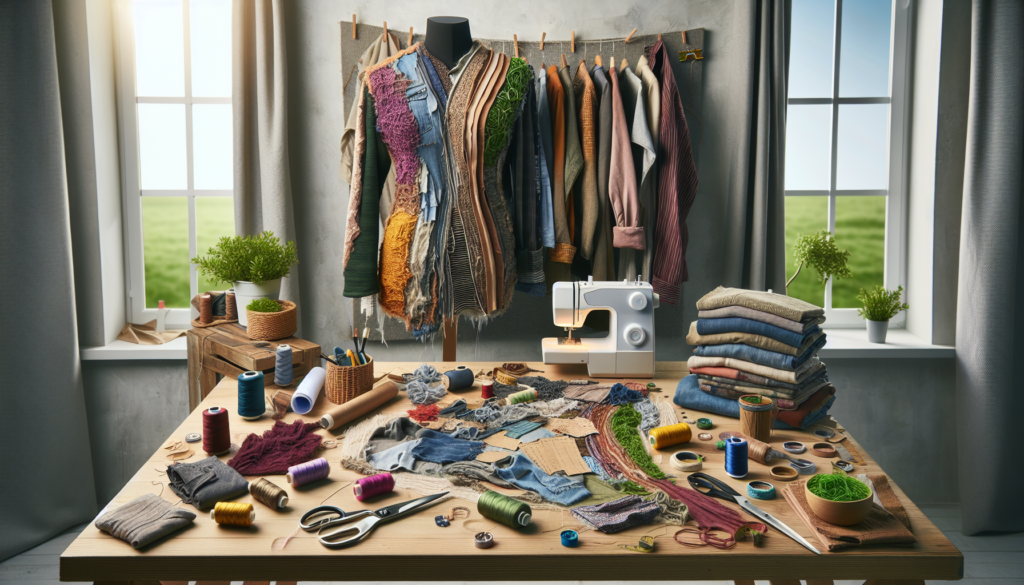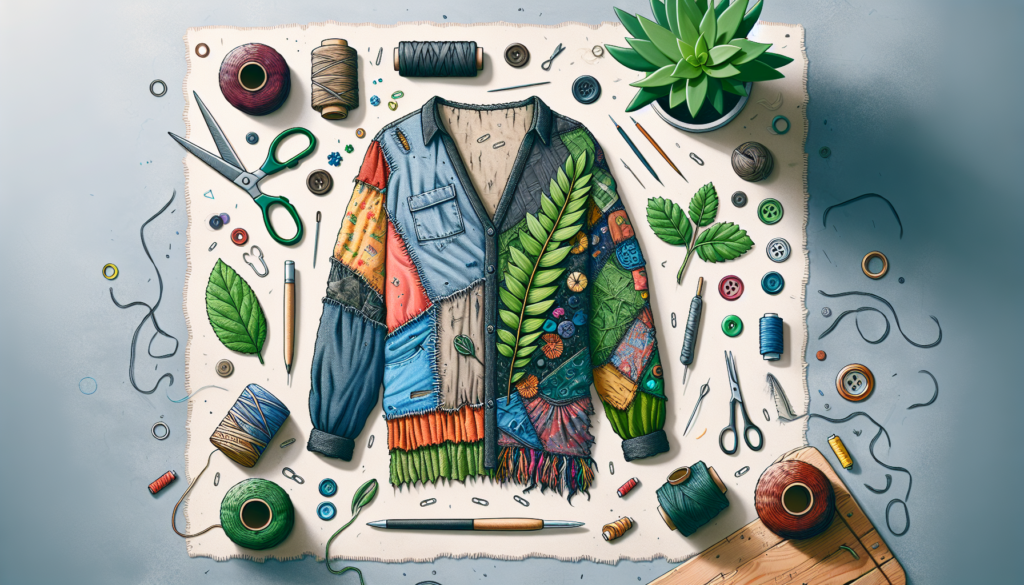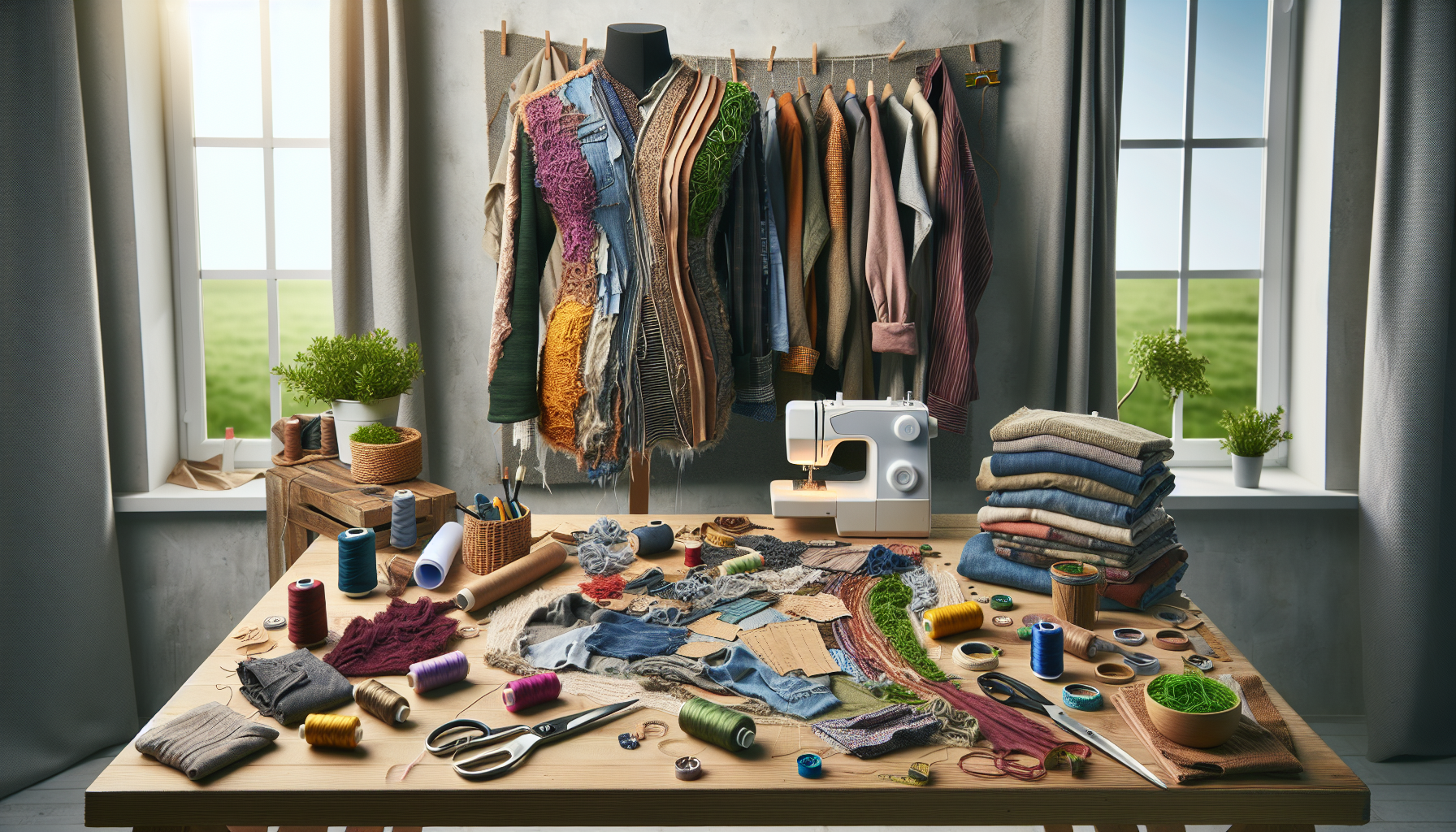Hey, fashionista! Are you tired of buying new clothes every season? Well, guess what? There’s a sustainable and trendy solution for you – upcycling your old clothes! In this article, we’re going to show you how to revamp your wardrobe and reduce your environmental footprint through the art of upcycling. From transforming an old shirt into a stylish tote bag to turning worn-out jeans into a chic denim skirt, we’ve got you covered. So grab your scissors and let’s get creative!
Why Upcycling is Important
Reduce Waste and Carbon Footprint
Upcycling old clothes is an essential step in reducing waste and minimizing our carbon footprint. The fashion industry is one of the largest contributors to pollution and waste generation, with millions of tons of clothing ending up in landfills each year. By repurposing and upcycling old clothes, we can prevent them from being discarded and put them to good use instead. This not only reduces waste but also reduces the demand for new clothing production, which consumes valuable resources and contributes to greenhouse gas emissions.
Extend the Lifespan of Clothing
In today’s fast-paced world of fashion, clothing is often seen as disposable. Trends come and go, and garments are quickly discarded when they go out of style or show signs of wear. However, by upcycling old clothes, we can extend their lifespan and give them a second chance. With a little creativity and some simple techniques, we can transform tired or outdated garments into fresh and stylish pieces that can be enjoyed for years to come.
Reduce the Demand for Fast Fashion
Another significant reason why upcycling is important is that it helps reduce the demand for fast fashion. Fast fashion refers to the rapid production and sale of inexpensive clothing, often at the expense of ethical and sustainable practices. By upcycling old clothes, we are actively participating in a movement against the negative impacts of fast fashion. Instead of constantly buying new clothes, we can turn to our existing wardrobe and give it a new lease on life. This not only saves money but also promotes a more sustainable and mindful approach to fashion consumption.
Benefits of Upcycling Old Clothes
Creative Outlet for Personal Style
Upcycling old clothes is a fantastic creative outlet that allows you to express your personal style in a unique and individual way. By repurposing garments, you have the freedom to experiment with different colors, textures, and techniques, creating one-of-a-kind pieces that truly reflect your personality. Whether you prefer a bohemian look, a minimalist style, or something entirely original, upcycling gives you the opportunity to create garments that cannot be found anywhere else.
Saves Money on New Clothing
One of the most practical benefits of upcycling old clothes is the money-saving aspect. Fashion can be a costly pursuit, with new trends constantly enticing us to update our wardrobes. However, by upcycling, you can save a significant amount of money by giving new life to items you already own. Instead of splurging on new clothes every season, you can instead invest your time and creativity in transforming old favorites into fresh and exciting pieces. Not only does this save money but it also promotes a more sustainable and budget-friendly approach to fashion.
Adds Unique and One-of-a-Kind Pieces to Wardrobe
With upcycled clothing, you can create unique and one-of-a-kind pieces that add a touch of individuality to your wardrobe. In a world where mass-produced fashion dominates, having garments that are truly one-of-a-kind is a rare gem. By upcycling, you can personalize your clothing with unique embellishments, prints, or alterations that make a fashion statement without breaking the bank. These special pieces become conversation starters, giving you the opportunity to share the story of their transformation and inspire others to embrace sustainable fashion.

Step 1: Assess Your Wardrobe
Sort and Organize
Before diving into upcycling, it’s essential to assess your wardrobe and get organized. Start by sorting your clothes into categories such as tops, pants, dresses, and accessories. This will give you a clear picture of what you have and help you identify potential candidates for upcycling. It’s also an excellent opportunity to declutter and donate items that no longer serve you.
Identify Potential Upcycling Candidates
Once you’ve sorted and organized your wardrobe, take a closer look at each garment to identify potential candidates for upcycling. Look for items that may be worn out, have stains or tears in specific areas, or simply don’t fit your style anymore. These are the pieces that can benefit the most from upcycling, as they have the potential to be transformed into something new and exciting.
Step 2: Choose the Upcycling Method
Dyeing and Tie-Dyeing
Dyeing or tie-dyeing is a popular and effective method of upcycling old clothes. It allows you to breathe new life into garments by changing their color or adding unique patterns. Whether you want to refresh a faded pair of jeans or turn a plain white t-shirt into a vibrant fashion statement, dyeing and tie-dyeing techniques offer endless possibilities for upcycling.
Cutting and Sewing
Cutting and sewing are versatile techniques that can transform old clothes into entirely new garments or accessories. Whether it’s turning a pair of jeans into stylish shorts or creating a tote bag from an old t-shirt, cutting and sewing allow you to unleash your creativity and give your clothes a fresh and modern look.
Embroidery and Appliqué
Embroidery and appliqué are excellent techniques for adding intricate details and personalizing your upcycled garments. Whether you choose to hand stitch a delicate floral pattern on a dress or add a fun appliqué to a plain t-shirt, these techniques can elevate your upcycled pieces and make them truly unique.
Prints and Stencils
Adding prints and stencils to your upcycled garments is a fun and creative way to make a bold fashion statement. From screen printing to block printing or even using stencils and fabric paint, you can easily add patterns or images to give new life to old clothes. Let your imagination run wild and create pieces that reflect your personal style.

Step 3: Gather Tools and Materials
Scissors, Needles, and Thread
To get started with upcycling, you’ll need some essential tools such as sharp scissors, needles of various sizes, and a collection of thread in different colors. These tools will come in handy when cutting, sewing, and adding embellishments to your upcycled garments.
Dye or Fabric Paints
Depending on the upcycling method you choose, you’ll need dye or fabric paints to change the color or add patterns to your old clothes. There are many eco-friendly and non-toxic options available, so choose the one that suits your needs and preferences.
Embroidery Floss and Needles
If you’re planning to incorporate embroidery or appliqué into your upcycling projects, gather embroidery floss in various colors and a selection of embroidery needles. These materials will ensure that you have everything you need to add intricate details and artistic touches to your garments.
Step 4: Techniques for Upcycling
Dyeing and Tie-Dyeing Techniques
When dyeing or tie-dyeing your old clothes, consider techniques such as immersion dyeing, ombre dyeing, or using natural dyes. Each technique offers a different effect, allowing you to create unique and eye-catching pieces.
Cutting and Sewing Techniques
There are numerous cutting and sewing techniques you can explore, depending on the garments you’re upcycling. From seam removal and resizing to adding new panels or creating ruffles, the possibilities are endless.
Embroidery and Appliqué Techniques
To incorporate embroidery or appliqué, experiment with different stitches such as backstitch, satin stitch, or French knots. Additionally, explore techniques like layering fabrics, adding lace or beads, or using iron-on patches for appliqué.
Print and Stencil Techniques
For print and stencil techniques, you can use ready-made stencils, create your own designs, or even try screen printing. Play around with different colors and patterns to achieve the desired effect and breathe new life into your old clothes.
Step 5: Upcycling Ideas for Different Garment Types
Tops and Blouses
For tops and blouses, consider transforming long-sleeved shirts into trendy off-the-shoulder tops, adding lace or embroidery to plain t-shirts, or turning oversized button-down shirts into stylish wrap tops.
Pants and Jeans
Pants and jeans offer endless possibilities for upcycling. Some ideas include turning old jeans into distressed shorts, adding patches or embroidery to ripped or faded jeans, or transforming wide-legged pants into trendy culottes.
Dresses and Skirts
With dresses and skirts, you can turn maxi dresses into flowy skirts, add panels or ruffles to update a plain dress, or even incorporate a different fabric to create a contrasting hemline.
Accessories
Don’t forget about accessories when it comes to upcycling. You can transform old scarves into headbands or belts, repurpose fabric scraps into statement earrings, or even create unique bags using old fabric or leather.
Step 6: Tips for Successful Upcycling
Start with Simple Projects
If you’re new to upcycling, it’s best to start with simple projects and gradually work your way up to more complex ones. This allows you to gain confidence and develop your skills before taking on more challenging upcycling endeavors.
Take Measurements and Create Patterns
Before cutting or altering your old clothes, always take measurements and create patterns if necessary. This ensures a better fit and helps you visualize how the final piece will look. Remember, preparation is key to successful upcycling.
Experiment and Have Fun
Upcycling should be a fun and creative process, so don’t be afraid to experiment and try new things. Mix and match techniques, combine unexpected colors or patterns, and let your imagination run wild. The beauty of upcycling lies in the freedom it offers to express your unique style.
Step 7: Care and Maintenance of Upcycled Clothing
Washing and Drying
When it comes to caring for your upcycled clothing, follow the care instructions for the original fabrics. Most upcycled pieces can be safely washed by hand or in a washing machine on a gentle cycle. However, be mindful of any delicate embellishments or fabrics that may require extra care.
Repairing and Reinforcing Seams
As with any clothing, upcycled garments may require occasional repairs or reinforcement of seams. Keep a supply of needles, thread, and fabric patches on hand to address any minor damages promptly. This will help prolong the lifespan of your upcycled pieces.
Storing Upcycled Pieces
To ensure that your upcycled pieces remain in good condition, store them properly when not in use. Fold them neatly and place them in a cool, dry place away from direct sunlight to prevent fading or damage. Consider using storage bags or boxes to protect delicate garments from dust or pests.
Further Resources and Inspiration
Books and Online Tutorials
To further explore the world of upcycling and gain inspiration, consider checking out books or online tutorials. There are countless resources available that provide step-by-step instructions, project ideas, and tips from experienced upcyclers.
Local Workshops and Classes
If you prefer a more hands-on approach, look for local workshops or classes that focus on upcycling and sustainable fashion. These provide an excellent opportunity to learn new techniques, connect with like-minded individuals, and gain valuable skills.
Sustainable Fashion Communities and Events
Engaging with sustainable fashion communities and attending events can provide you with a wealth of inspiration and support. Join online groups or forums where people share their upcycling projects, attend eco-fashion shows or swap events, and immerse yourself in a community that values and promotes sustainable fashion.
By embracing the art of upcycling, you not only contribute to reducing waste and the demand for fast fashion but also tap into your creativity and cultivate a more sustainable and mindful approach to your wardrobe. Every upcycled garment is a small step towards a more eco-friendly and fashion-forward future. So, gather your old clothes, unleash your creativity, and start upcycling today!

